
Guest Blogged By John Gideon
Vote-PAD is a low-tech, voting assistive device that was developed with input from the disabilities community. Because it is inexpensive to purchase and maintain, Vote-PAD is a threat to electronic voting systems. Vote-PAD also makes voting a possibility for a wider range of voters with disabilities than do almost all of the Direct Recording Electronic (DRE) or touch-screen voting systems.
Even though some northern California counties had already purchased Vote-PAD for use in their elections as their HAVA compliant voting system for voters with disabilities; the Secretary of State decided that they would have to certify Vote-PAD for use with the optical-scan systems that are in use in each of the user counties.
The state then wrote a test plan that was totally unfair to the voters with disabilities who were expected to test the Vote-PAD. The state did not use a Human Factors Usability Testing Expert, an expert in writing test procedures for disabilities access. Instead they wrote a procedure that would have been better suited to testing a computerized voting system and they appear to have done this without really understanding how voters with disabilities actually use the device.
It is important to note that the state of California has certified for use many voting systems produced by Sequoia, Elections Systems and Software, Diebold, and Hart Intercivic. These devices have been certified by the state as being HAVA compliant and usable by voters with disabilities. Yet, not one of the electronic voting systems has been tested specifically by the disabilities community or even advocates for that community. Instead, a cursory inspection was made by unqualified staff and/or unqualified consultants and they were all accepted for use.
On July 19 and 20 testing was accomplished with members of the disabilities community invited to come in and test the Vote-PAD. Unfortunately what the testers found was that they were not going to be allowed to use the device as if it was a real election. Instead there were staff members there prompting them on actions that they were to take that no one would ever have to take in a real election.
The staff members themselves were not familiar with Vote-PAD as they had had no training on its use until a day before the testing began. The state also required Freeman, Craft, and McGregor Group, who provide consultants reports for computerized voting systems in California, to come in and provide a 'consultants report' on the Vote-PAD testing and to assist with the testing. The consultants were also not familiar with the device until the day before testing and their questionable expertise is in computerized voting systems.
Vote-PAD points out in "Discrepancies Between Vote-PAD Test Protocol and Implementation" that monitors and consultants had not become familiar with Vote-PAD until just prior to the testing and, in some cases, they were still unfamiliar with its use as they were doing the testing.
In a just published letter to Secretary of State Bruce McPherson, Vote-PAD President Ellen Theisen and Vice-President Dianna Smith describe their problems with the way the test was devised and conducted:
Not too surprising is the fact that the staff of the Secretary of State has decided to recommend against certification of Vote-PAD.
It is clear that the Secretary of State of California had no interest in seeing Vote-PAD get a good recommendation. Members of the disabilities community are the real loser in this game as they lose a means of voting that is totally accessible.
Press Release On Press Conference and Public Hearing
For Immediate Release
California Election Protection Network
Press Contact: Dan Ashby 510-233-2144
CA Elections Staff Advises Against Non-electronic Voting Alternative for Disabled
Election activists support VotePAD as secure, low-cost, more accessible than electronic voting machines
Date: Wednesday, August 9, 2006
Time: Demonstration and press conference, 9:00 a.m.
State voting system certification hearings, 10:00 a.m.
Place: Secretary of State’s Office at 1500 11th Street, Sacramento, CA
Event: Demonstration and press conference by California Election Protection Network prior to state voting systems certification hearing
Subject: Vote-PAD is the first non-computerized voting assistive device to be proposed for use in California elections to enable persons with disabilities to vote independently at the polls using paper ballots. The VotePAD is being evaluated for possible use as a disability access solution in conjunction with optical scan electronic voting systems by vendors Hart (System 6.2) and Diebold (GEMS-Accu-Vote OS).
--------------------------------------------------------------------------------
Staff and consultants of the California Elections Division have issued negative evaluation reports recommending against state certification of the VotePAD assistive device intended to help disabled voters cast their votes independently. The Secretary of State usually follows the recommendations of the Voting Systems Technology Assessment Advisory Board in making voting system certification decisions.
At the same time as it released the negative assessment of VotePAD--late on Friday August 4, affording the public little time to respond--the VSTAAB also recommended certification of a suite of electronic voting devices and software applications by the e-voting vendor Hart Intercivc. The board gave the Hart system a pass, despite noting performance failures such as this one regarding the system's Tally software component that reads, stores and tabulates ballot images: "As in the previous version, Tally still cannot report vote results directly in the granularity required for the Supplement to the Statement of Vote (SSOV)."
The state reports on the VotePAD and Hart System 6.2 are available at http://ss.ca.gov/elections/elections_vs.htm.
Election integrity activists were dismayed by the negative assessment of VotePAD, and will be attending the certification hearing Wednesday urging at least a conditional certification of Vote-PAD as a secure voting alternative that solves disability access problems that the currently certified electronic voting machines frequently cannot (see http://www.vote-pad.us/testimonials.asp).
VotePAD proponents would like to see a noncomputerized alternative to electronic voting machines that are currently promoted as the only solution for disabled voting access requirements set in federal law.
Ann West, a longtime California grassroots election activist and educator, said, “Citizens shouldn’t let corporations that sell electronic voting machines monopolize this field. There must be a diversity of choices to provide real competition.”
Dr. Forrest Hill, Green Party candidate for Secretary of State, said, "I’ve been pushing for alternatives such as this. It’s not a product endorsement, it’s a matter of principle. There must be an alternative--a non-computerized transparent means of voting. I support what Freddie Oakley, the County Clerk of Yolo says, about the Vote-PAD, that it's 'no more hackable than a number 2 pencil.' So far, in tests with voters, including those with disabilities, everyone likes it."
[For VotePAD descriptions, see http://www.vote-pad.us/ and http://www.wired.com/new...chnology/0,70036-0.html].
Sherry Healy of the California Election Protection Network points out, “The recent lawsuit against five California counties shows that disability organizations are dismayed that electronic systems only allow sighted voters to verify their paper ballot. The Vote-PAD deserves their support, since it provides a direct method of vote verification to everyone."
[See http://moritzlaw.osu.edu...tokaji/PVA-Complaint.pdf ].
The VotePAD vendor had offered to arrange the participation of a wide range of disability advocacy organizations in the VotePAD testing trials (see http://www.opednews.com/...vote_pad_invites_peo.htm), but this offer was quashed by the Voting Systems Testing and Assessment Board appointed by Secretary of State Bruce McPherson.
The board limited test participation to a small number of undisclosed disability testers that the board selected, and barred the public from observing the trials, held July 19 and 20 at the Secretary of State offices. VotePAD proponents say the board conducted testing without adequate preparation or expert competence in usability testing criteria and methods for persons with disabilities. [See http://www.vote-pad.us/M.../CACertTestResponse.asp].
Election activists also question apparent double-standards in state testing procedures that subject electronic system vendors to less stringent usability testing than that applied in the VotePAD trials.
"Why aren’t other systems being tested this way?" asks A.J. Devies, Disabilities Consultant to the Florida Fair Elections Coalition. "Is the Secretary of State discriminating against this non-electronic system by holding it to a different standard?”
Election integrity activists have testified in protest at numerous California voting system certification hearings over the past two years objecting to the state certification of electronic machines that fail to meet the accessibility standard for non-visible (audio) means of voter verification required by California law SB 1438 and incorporated in the state Elections Code [see http://info.sen.ca.gov/p...20040927_chaptered.html].
"Direct record electronic"(DRE) voting machines have been heavily promoted as the solution to voting access for the disabled since the passage of the Help America Vote Act of 2002, which made available the financial inducement of $3.8 billion in one-time federal grants for voting equipment upgrades. Election integrity activists have denounced electronic voting machines as "Trojan horses" that open up the electoral process to covert hacking manipulations that can falsify election results without detection.
(See http://www.blackboxvoting.org/BBVreport.pdf, http://www.blackboxvoting.org/BBVtsxstudy.pdf, http://www.openvotingfou..._article.php?articleId=1).
That assessment has been affirmed by overwhelming consensus among computer security professionals
(see http://www.acm.org/annou...mendation.9-27-2004.html) and by real-world demonstrations of exactly such hacking exploits, that election officials including Secretary McPherson and the federal Election Assistance Commission have been obliged to acknowledge with special security advisories
(see (http://www.ss.ca.gov/executive/press_releases/2006/06_021.pdf and http://www.nased.org/ITA...mory%20Card%20Report.pdf).
Those revelations have in turn been the basis for a growing number of legal actions challenging electronic voting and the trade-secret proprietary claims of e-voting vendors as antithtetical to guarantees of voting rights and open government afforded citizens by their state constitutions (see http://www.atla.org/homepage/trial.aspx).
An additional consideration election activists point out is the high purchase cost and continuing maintenance expense of DRE voting machines, which they say could be avoided by the adoption of sensible, low-cost, appropriate voting technology such as the Vote PAD and a similar voting assistive device called the Equalivote (http://www.equalivote.com/pg2b.html).
Stu Schy of Santa Rosa, a systems usability consultant with over 20 years' experience working with the disability community, says "Sonoma County paid $4.7 million for the equipment used in the June 6 primary, and only $1.4 million was covered by HAVA. The number of votes cast on the machines was 165. That's over $28,000 per vote! We need and want a low-cost alternative."
Casey Hanson of the Oregon Voter Rights Coalition sums it up: “The nation looks to California for its leadership role. We’re all watching and we hope that the public will show up to show their support for having Vote-PAD as an alternative to computerized voting systems.”
--
Dan Ashby
E-mail: ca.voteraction@sbcglobal.net
Phone: 510-233-2144
Voicemail and Fax: 510-740-0572
UPDATE: A correction was made to the media release. The Voting Systems Technology Assessment Advisory Board is not normally involved in the testing process in a manner where they would provide recommendations or input to the Secretary of State. Staff members do the testing and make those recommendations.
Disclosure Statement:
In the interest of full disclosure: Ellen Theisen was the founder of VotersUnite and its Executive Director before I took over the helm from her. She resigned from her position upon founding Vote-PAD, Inc. I have no stake in Vote-PAD in any way except as Ellen's friend.


 Sunday 'Close Enough' Toons
Sunday 'Close Enough' Toons A Pretty Weak 'Strongman': 'BradCast' 10/30/25
A Pretty Weak 'Strongman': 'BradCast' 10/30/25 'Green News Report' 10/30/25
'Green News Report' 10/30/25
 Proposal for 'First Politically Viable Wealth Tax' Takes Shape in CA: 'BradCast' 10/29/25
Proposal for 'First Politically Viable Wealth Tax' Takes Shape in CA: 'BradCast' 10/29/25 Monster Storm, Endless Wars, Gamed Elections:
Monster Storm, Endless Wars, Gamed Elections: 'Green News Report' 10/28/25
'Green News Report' 10/28/25 Let's Play 'Who Wants
Let's Play 'Who Wants Sunday 'Cartoonists Dilemma' Toons
Sunday 'Cartoonists Dilemma' Toons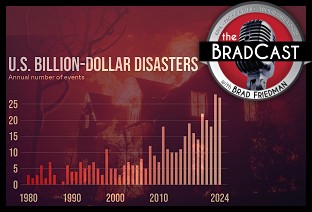 Exiled NOAA Scientists Resurrect Critical Disaster Database: 'BradCast' 10/23/25
Exiled NOAA Scientists Resurrect Critical Disaster Database: 'BradCast' 10/23/25  'Green News Report' 10/23/25
'Green News Report' 10/23/25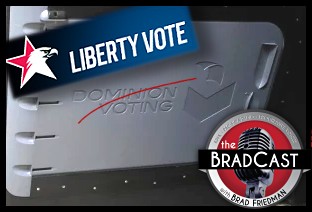 Trump-Allied GOP Partisan Buys Dominion Voting Systems: 'BradCast' 10/22/25
Trump-Allied GOP Partisan Buys Dominion Voting Systems: 'BradCast' 10/22/25 Trump, Republican Law(lessness) & (Dis)Order: 'BradCast' 10/21/25
Trump, Republican Law(lessness) & (Dis)Order: 'BradCast' 10/21/25 'Green News Report' 10/21/25
'Green News Report' 10/21/25 Celebrating 'No Kings': 'BradCast' 10/20/25
Celebrating 'No Kings': 'BradCast' 10/20/25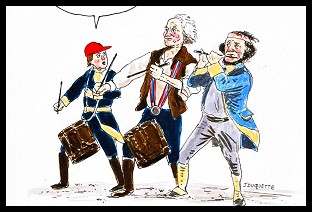 Sunday 'How It Started' Toons
Sunday 'How It Started' Toons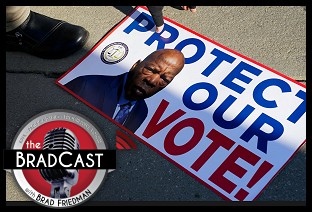 SCOTUS Repubs Appear Ready to Gut Rest of Voting Rights Act: 'BradCast' 10/16/25
SCOTUS Repubs Appear Ready to Gut Rest of Voting Rights Act: 'BradCast' 10/16/25 'Green News Report' 10/16/25
'Green News Report' 10/16/25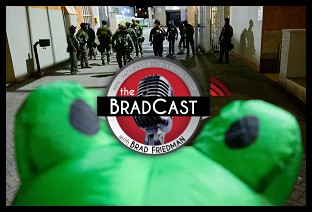 The 'Epstein Shutdown' and Other Autocratic Nightmares: 'BradCast' 10/15/25
The 'Epstein Shutdown' and Other Autocratic Nightmares: 'BradCast' 10/15/25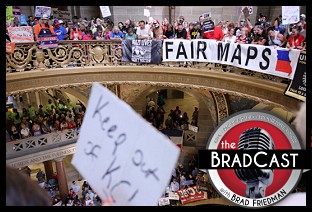 Group Vows to Block MO's GOP U.S. House Gerrymander: 'BradCast' 10/14/25
Group Vows to Block MO's GOP U.S. House Gerrymander: 'BradCast' 10/14/25 Trump Labor Dept. Warns Trump Policies Sparking Food Crisis: 'BradCast' 10/9/25
Trump Labor Dept. Warns Trump Policies Sparking Food Crisis: 'BradCast' 10/9/25 Trump's Losing Battles: 'BradCast' 10/8/25
Trump's Losing Battles: 'BradCast' 10/8/25 Trump, Roberts and His Stacked, Packed and Captured SCOTUS: 'BradCast' 10/7/25
Trump, Roberts and His Stacked, Packed and Captured SCOTUS: 'BradCast' 10/7/25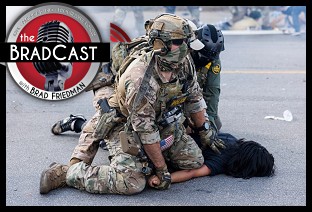 Trump Attempting His 'Invasion from Within': 'BradCast' 10/6/25
Trump Attempting His 'Invasion from Within': 'BradCast' 10/6/25 Biden Budget Expert: Mass Firings in Shutdown 'Illegal': 'BradCast' 10/2/25
Biden Budget Expert: Mass Firings in Shutdown 'Illegal': 'BradCast' 10/2/25 Why is DOJ Suing 'Blue' States for Their Voter Databases?: 'BradCast' 10/1/25
Why is DOJ Suing 'Blue' States for Their Voter Databases?: 'BradCast' 10/1/25
 VA GOP VOTER REG FRAUDSTER OFF HOOK
VA GOP VOTER REG FRAUDSTER OFF HOOK Criminal GOP Voter Registration Fraud Probe Expanding in VA
Criminal GOP Voter Registration Fraud Probe Expanding in VA DOJ PROBE SOUGHT AFTER VA ARREST
DOJ PROBE SOUGHT AFTER VA ARREST Arrest in VA: GOP Voter Reg Scandal Widens
Arrest in VA: GOP Voter Reg Scandal Widens ALL TOGETHER: ROVE, SPROUL, KOCHS, RNC
ALL TOGETHER: ROVE, SPROUL, KOCHS, RNC LATimes: RNC's 'Fired' Sproul Working for Repubs in 'as Many as 30 States'
LATimes: RNC's 'Fired' Sproul Working for Repubs in 'as Many as 30 States' 'Fired' Sproul Group 'Cloned', Still Working for Republicans in At Least 10 States
'Fired' Sproul Group 'Cloned', Still Working for Republicans in At Least 10 States FINALLY: FOX ON GOP REG FRAUD SCANDAL
FINALLY: FOX ON GOP REG FRAUD SCANDAL COLORADO FOLLOWS FLORIDA WITH GOP CRIMINAL INVESTIGATION
COLORADO FOLLOWS FLORIDA WITH GOP CRIMINAL INVESTIGATION CRIMINAL PROBE LAUNCHED INTO GOP VOTER REGISTRATION FRAUD SCANDAL IN FL
CRIMINAL PROBE LAUNCHED INTO GOP VOTER REGISTRATION FRAUD SCANDAL IN FL Brad Breaks PA Photo ID & GOP Registration Fraud Scandal News on Hartmann TV
Brad Breaks PA Photo ID & GOP Registration Fraud Scandal News on Hartmann TV  CAUGHT ON TAPE: COORDINATED NATIONWIDE GOP VOTER REG SCAM
CAUGHT ON TAPE: COORDINATED NATIONWIDE GOP VOTER REG SCAM CRIMINAL ELECTION FRAUD COMPLAINT FILED AGAINST GOP 'FRAUD' FIRM
CRIMINAL ELECTION FRAUD COMPLAINT FILED AGAINST GOP 'FRAUD' FIRM RICK SCOTT GETS ROLLED IN GOP REGISTRATION FRAUD SCANDAL
RICK SCOTT GETS ROLLED IN GOP REGISTRATION FRAUD SCANDAL VIDEO: Brad Breaks GOP Reg Fraud Scandal on Hartmann TV
VIDEO: Brad Breaks GOP Reg Fraud Scandal on Hartmann TV RNC FIRES NATIONAL VOTER REGISTRATION FIRM FOR FRAUD
RNC FIRES NATIONAL VOTER REGISTRATION FIRM FOR FRAUD EXCLUSIVE: Intvw w/ FL Official Who First Discovered GOP Reg Fraud
EXCLUSIVE: Intvw w/ FL Official Who First Discovered GOP Reg Fraud GOP REGISTRATION FRAUD FOUND IN FL
GOP REGISTRATION FRAUD FOUND IN FL

































